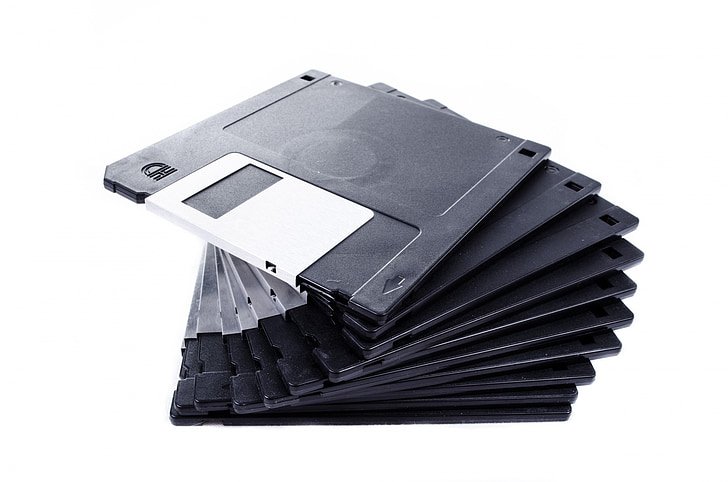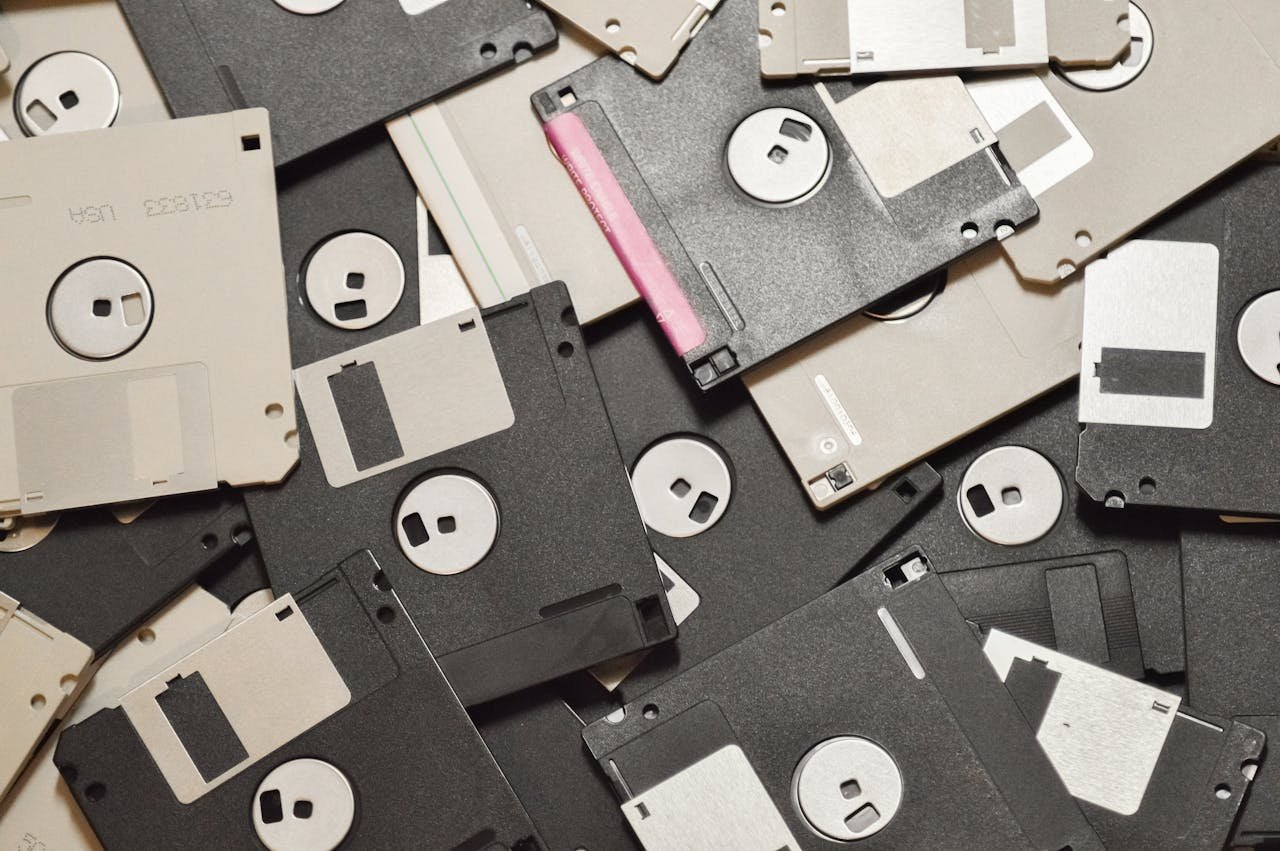The Floppy Disk, often affectionately referred to as Floppies, holds a significant place in the annals of computer history. Its journey from a revolutionary data storage innovation to a symbol of nostalgia and eventual obsolescence is a captivating tale that chronicles the ever-evolving landscape of technology. In this exploration, we journeyed through the History of Floppy Disk, tracing its inception, evolution, and ultimate decline.
The story of the Floppy Disk began in the late 1960s when IBM introduced the first-ever floppy disk, an 8-inch marvel that would soon set the stage for a revolution in data storage. However, the advent of the more compact and versatile 5.25-inch and 3.5-inch formats in the late 1970s and 1980s marked the Floppy Disk era. Encased in protective shells, these magnetic wonders quickly became the standard for data storage, making them synonymous with computing during that period.
The History of Floppy Disk is a testament to the relentless march of technological progress. As computing needs grew, so did the capacity of Floppies. High-Density (HD) 3.5-inch floppies emerged, boasting a storage capacity of 1.44 megabytes, while earlier models stored a fraction of that. Yet, their relatively small capacity was often a limitation in an increasingly data-hungry world.
The evolution of the Floppy Disk witnessed the rise of floppy drives as standard equipment on personal computers, serving as a primary means of software distribution, data backup, and file transfer. However, as the new millennium dawned, it became evident that the days of the Floppy Disk were numbered. The advent of CD-ROMs, USB drives, and other high-capacity storage solutions rendered the floppy obsolete.
Today, the Floppy Disk is a relic of a bygone era, cherished for its role in the early days of personal computing. While it has faded into obscurity, the History of Floppy Disk is a poignant reminder of the relentless pace of technological advancement and the nostalgia surrounding iconic computer storage mediums. The following pages will delve deeper into this fascinating journey, exploring the Floppy Disk’s innovations, challenges, and enduring legacy.
Table of Contents
What is a floppy disk and its uses?
A floppy disk, often referred to simply as a “floppy,” is a magnetic storage device widely used for data storage and transfer from the 1970s through the early 2000s. It consists of a thin, flexible plastic disk coated with a magnetic material enclosed in a square or rectangular protective shell. The most common size was the 3.5-inch floppy disk, but there were also 5.25-inch and 8-inch variants in the past.
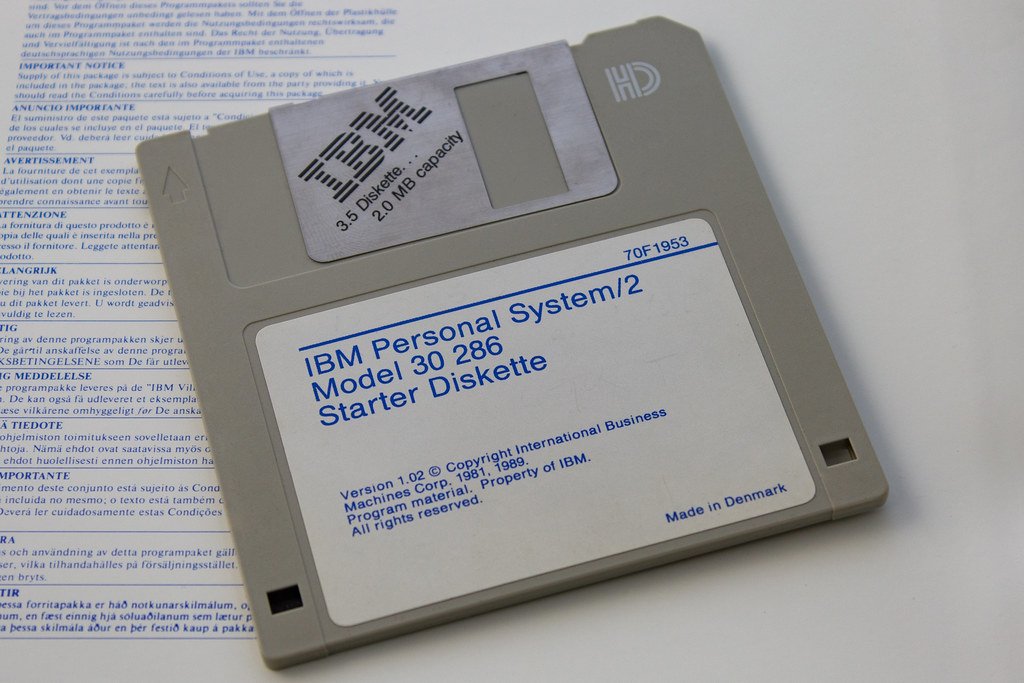
Floppy disks had several important uses:
Data Storage
Floppy disks were primarily used to store and transport small to moderate amounts of data, including documents, images, and software programs. They typically had capacities ranging from 360 kilobytes (KB) for early 5.25-inch disks to 1.44 megabytes (MB) for the more modern 3.5-inch disks.
Software Distribution
Floppies were a popular medium for distributing software, including operating systems, applications, and games. Users could install software by inserting a floppy disk into their computer’s floppy drive.
Backup and Data Transfer
Floppies often created backups for important files and transferred data between computers. They were portable and could be easily shared with others.
Bootable Disks
Floppies were used to start a computer when the operating system failed or to run diagnostics and recovery tools.
However, floppy disks have become largely obsolete due to their limited storage capacity, slow data transfer rates, and vulnerability to physical damage and data loss. They have been replaced by more advanced storage technologies such as USB drives, CDs/DVDs, and cloud storage, which offer larger capacities and greater reliability.
The History of Floppy Disks
Floppy disks, also known simply as “floppies,” were a widely used computer storage medium in the late 20th century. Here’s everything you need to know about floppy disks in detail:
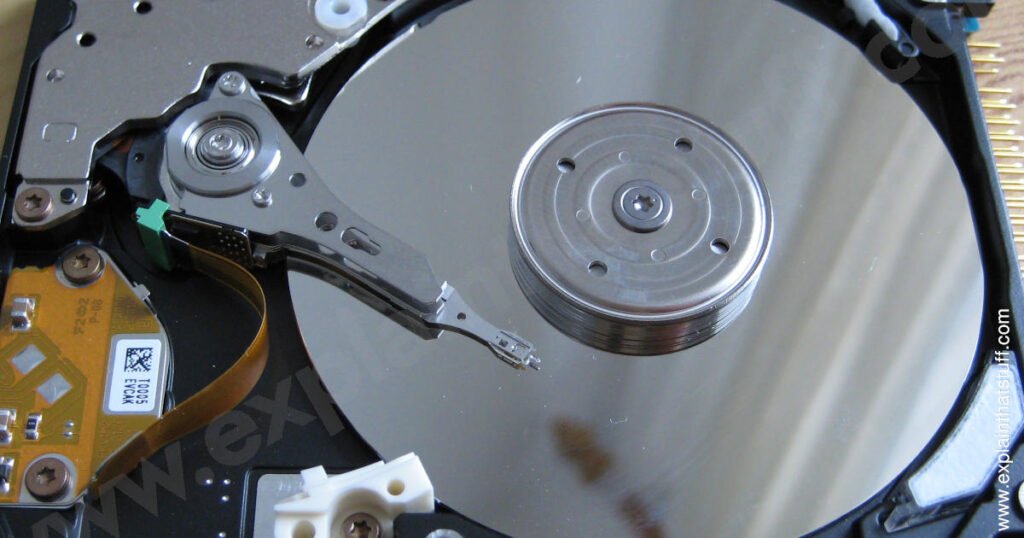
Introduction to Floppy Disks
The floppy disk, a ubiquitous and portable storage device, enjoyed widespread popularity from the 1970s to the late 1990s, making it an iconic symbol of the computer era’s early stages. This storage medium featured a distinctive construction of a slim, pliable plastic disk coated with a magnetic material securely enclosed within a protective plastic casing.
One notable aspect of floppy disks was their diverse sizes, with the 3.5-inch and 5.25-inch versions emerging as the most prevalent. The 3.5-inch floppy, known for its rigid plastic shell, boasted improved durability compared to its predecessors. On the other hand, the 5.25-inch format was larger and more flexible. Despite their differences, both versions played pivotal roles in data storage, software distribution, and data transfer during their heyday.
However, the allure of floppy disks began to wane with the advent of more capacious storage options such as CDs, USB drives, and external hard drives. While no longer at the forefront of data storage technology, floppy disks remain a nostalgic relic, symbolizing a bygone era of computing innovation and adaptation.
History
In the late 1960s, IBM pioneered a groundbreaking innovation in data storage by developing the first-ever floppy disk. This 8-inch marvel would set the stage for a revolution in computing. This 8-inch floppy disk, with its flexible, magnetic storage medium, marked a significant advancement in data storage technology at the time.
As computing needs continued to evolve, the 5.25-inch floppy disk debuted in the late 1970s and early 1980s. This smaller, yet still flexible, disk format quickly gained widespread popularity and became a staple in personal computing. It offered a more compact and convenient alternative to its larger predecessor.
However, the arrival of the 3.5-inch floppy disk in the 1980s truly transformed the data storage landscape. With its rigid plastic casing and higher storage capacity, the 3.5-inch floppy quickly became the standard choice for many years, serving as the primary means for data transfer, software distribution, and file storage in the emerging era of personal computing.
Physical Characteristics
In vintage computer storage, the 3.5-inch and 5.25-inch floppy disks stood as distinctive icons of an era when digital data was tangible. The 3.5-inch floppies, measuring just as their name suggests, were characterized by their square shape and robust, hard plastic shell. This design made them sturdy and less susceptible to damage than their predecessors.

On the other hand, the 5.25-inch floppies were notably larger and more flexible. Their increased size allowed for greater data storage capacity, a significant improvement over the earlier 8-inch floppy disks. One of the unique features of the 5.25-inch floppies was their sliding metal cover. This cover served a dual purpose—it protected the delicate magnetic surface of the disk from dust and physical damage while also serving as a write-protect mechanism. By sliding the metal cover into the open position, users could write or rewrite data, while sliding it closed prevented any accidental changes, ensuring the integrity of stored information. These distinct physical attributes contributed to the evolution and widespread use of floppy disks during the pioneering years of personal computing.
Storage Capacity
The storage capacity of a floppy disk indeed varied depending on its size and format, reflecting the evolution of this iconic data storage medium. The 3.5-inch High-Density (HD) floppy disks were among the most prominent and boasted a storage capacity of 1.44 megabytes (MB). This upgrade represented a significant leap in storage capability compared to earlier floppy disk iterations.
In contrast, the 5.25-inch floppy disks, while larger in physical size, typically offered more modest storage capacities. They were available in two common formats: 360 kilobytes (KB) and 1.2 megabytes (MB). The 360 KB version was the earlier standard, while the 1.2 MB variant was introduced later to accommodate larger files and applications.
These varying capacities reflected the ongoing efforts to meet the increasing demands for data storage as computing technology advanced. Despite their relatively small storage sizes by today’s standards, floppy disks played a pivotal role in the early days of personal computing, serving as a ubiquitous means for storing and transferring data, software, and documents.
Data Storage
Floppy disks, iconic storage devices of a bygone era, relied on magnetic principles for data storage. A critical component in this process was the read/write head—a tiny electromagnet positioned at the end of an actuator arm. This head had a dual role: reading existing data from the disk and writing new information onto it.
As the disk rotated within the drive, the read/write head would glide over its surface, in close proximity but not in direct contact. The magnetic coating on the disk was divided into concentric circles known as tracks. Each track was further subdivided into smaller units called sectors. This organization allowed for efficient and systematic storage of data.

When data was written to the floppy disk, the read/write head would generate tiny magnetic fields, aligning the particles on the disk’s surface to represent binary data. During the reading process, the head would detect these magnetic changes and convert them back into digital information for the computer to process.
This magnetic dance between the read/write head and the disk’s surface was the essence of how floppy disks stored and retrieved data. It was a delicate and precise mechanism that made these storage devices both revolutionary and, eventually, a relic of computing history.
Usage
Floppy disks were a versatile and ubiquitous medium for storing digital data in the late 20th century. They were primarily employed for the storage of small-sized files, essential documents, and computer programs. Their relatively limited storage capacity, especially in the case of the 3.5-inch floppies with 1.44 MB, made them suitable for text documents, basic spreadsheets, and simple programs.
One of their most common uses was as a means of transferring files between computers. Before the widespread adoption of high-speed internet and USB drives, individuals and businesses relied on floppy disks to share data. Whether it was sending a report to a colleague or exchanging software between friends, floppy disks were the go-to choice for this purpose.
Additionally, floppy disks played a crucial role in data backup. Users regularly copy important files onto floppy disks to safeguard against data loss due to hardware failures or software issues. While their storage capacity was limited, they provided a convenient solution for preserving critical information in an era where alternative backup options were limited or expensive.
Challenges and Limitations
Floppy disks, despite their widespread use, had several inherent vulnerabilities and limitations that made them less than ideal for certain applications. One significant drawback was their susceptibility to data corruption and loss, particularly when exposed to magnetic fields or physical damage. The magnetic material on the disk’s surface was sensitive, making it prone to accidental erasure or degradation over time.
Another limitation of floppy disks was their relatively small storage capacity. While they were suitable for storing documents, small programs, and modest amounts of data, they quickly became impractical for larger files as technology advanced. Multimedia files, complex software, and large databases simply could not fit within the confines of a floppy disk.
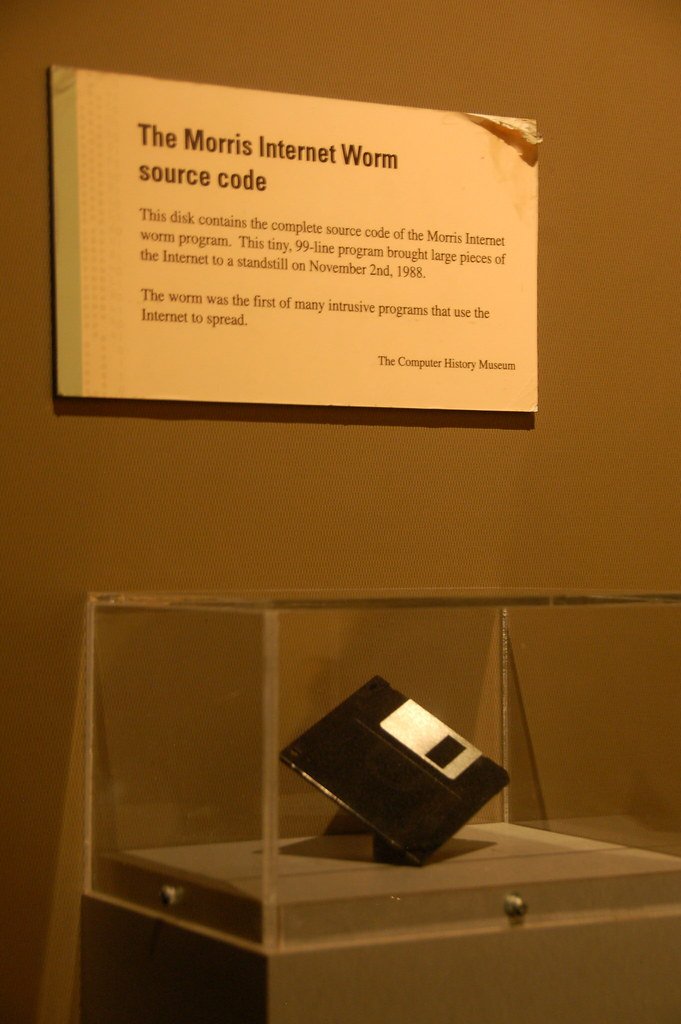
Furthermore, slow data transfer speeds were a common issue, especially as file sizes increased. The process of reading from or writing to a floppy disk was notably slower compared to modern storage solutions like hard drives or USB drives. This sluggish data transfer speed further hindered their utility in an era when efficiency and speed were becoming increasingly important in computing. Despite these limitations, floppy disks played a crucial role in the early days of personal computing, paving the way for the high-capacity storage options we have today.
Replacement and Decline
Floppy disks, once the workhorses of data storage, began their decline in the late 1990s as more advanced storage technologies emerged. The widespread adoption of CD-ROMs and the increasing prevalence of USB drives signaled a shift towards larger-capacity and more reliable storage solutions. CD-ROMs, with their capacity for storing hundreds of megabytes or even gigabytes of data, made them ideal for software distribution, multimedia content, and backups.
By the early 2000s, a significant turning point was reached when most new computers were not equipped with floppy disk drives. This shift reflected the diminishing relevance of floppy disks in the face of more efficient, faster, and spacious alternatives. USB drives, in particular, emerged as versatile and portable devices capable of storing gigabytes of data. The era of floppy disks had officially come to a close, marking the end of an iconic chapter in the history of computing.
Legacy
Despite their obsolescence, floppy disks hold a special place in the annals of early computing history. These once-ubiquitous storage devices, now largely relics of the past, are remembered as iconic symbols of a bygone era in the ever-advancing world of technology.
In contemporary times, floppy disks are often employed as symbolic representations, especially in digital interfaces. The universal “save” icon, typically depicted as a small 3.5-inch floppy disk, is a nostalgic homage to these once-prized storage mediums. It’s a testament to their enduring cultural significance, even as newer and more capacious storage solutions have taken their place.
Moreover, floppy disks have carved out a niche in retrocomputing. Enthusiasts and collectors fondly embrace these vintage artifacts, preserving and celebrating the technology of yesteryears. For them, floppy disks are not just obsolete relics but gateways to reliving the early days of personal computing, a tangible connection to the past that reminds us of how far technology has come.
Preservation
As the years pass, the reliability of floppy disks as a storage medium has steadily declined. This decline is primarily due to the gradual degradation of their magnetic properties, making the data recovery process from aging floppies increasingly challenging. Over time, exposure to environmental factors such as temperature fluctuations and humidity can cause the magnetic material on the disk to weaken and lose its ability to hold data securely. This significantly threatens valuable historical information and digital artifacts stored on floppy disks.
Recognizing the importance of preserving the data contained in these obsolete but historically significant storage devices, concerted efforts are now underway. Archives, museums, and preservationists actively engage in initiatives to archive and safeguard the data stored on floppy disks. This involves transferring the data to more stable and modern storage media, such as digital archives or emulated systems, to ensure that the legacy of these early computing artifacts is not lost to the ravages of time. Doing so allows us to continue learning from and appreciating computing technology’s history and evolution.
Compared to contemporary solutions, floppy disks were a vital cornerstone of early personal computing despite their limited storage capabilities. Their significance lay in their role as a primary means of storing and distributing computer software and data during their heyday. These humble, flexible disks facilitated the spread of digital knowledge and applications, laying the foundation for today’s digital era. While floppy disks have long been rendered obsolete by more spacious and efficient storage alternatives, they endure as nostalgic relics, evoking memories of a simpler, pioneering time in the history of computing.







